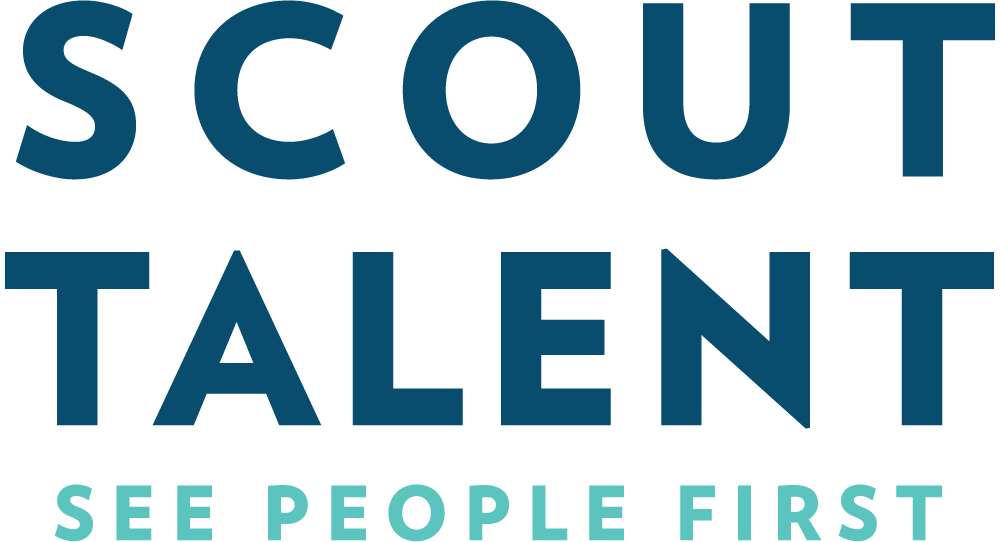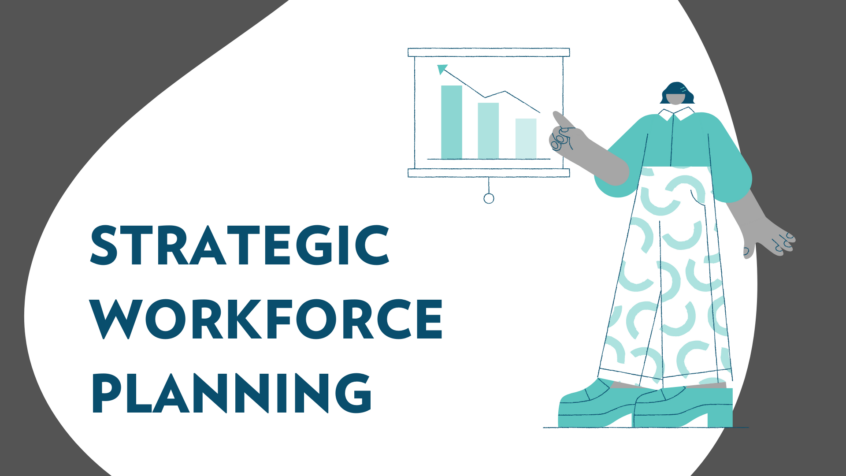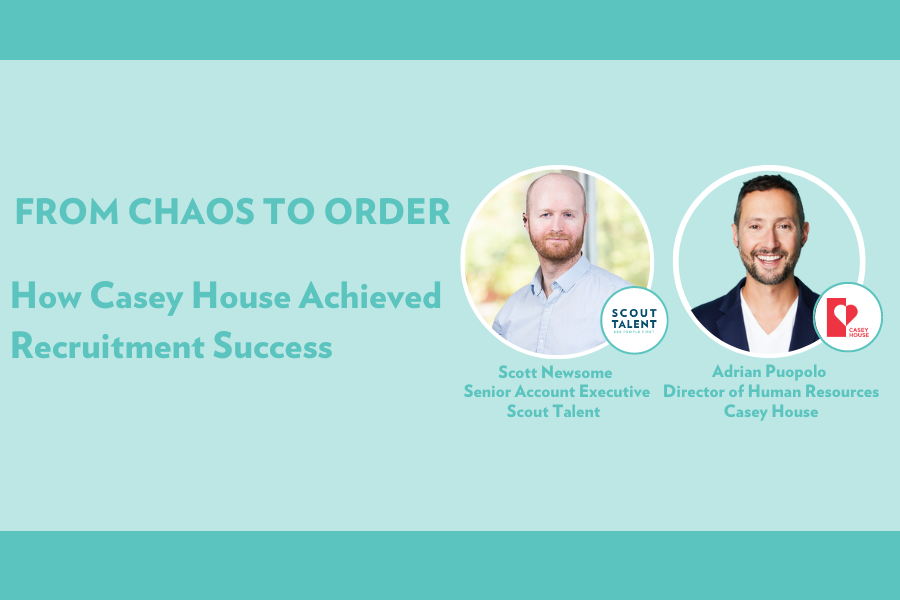There is a lot of talk about what constitutes a “future-ready” organization, and what that looks like for small to medium-sized establishments. A major theme in recent years is adaptability. The last eighteen months, in particular, enshrined the old adage that change is the only constant. And to be adaptable to change, organizations must be creative, antifragile, and collaborative. They must make important decisions informed by real-time data, keeping long-term timelines flexible. There is still a need for strategic workforce planning, you just have to turn it on its head. Breaking down your strategic goals into manageable business moves enables you to drive high-level plans for the future. The key is to adopt a proactive hiring strategy and to always leave room for change along the way.
The nuts and bolts of strategic workforce planning
In essence, strategic workforce planning is a strategy to build a strong workforce that serves your organization in the short and long term. You aim to have the right team member in the right role at the right time. The strategy assesses your current team, trends in your industry, and relevant analytics to predict future demands on your resources. It’s not just about meeting labor needs – it’s also about retaining your current team, developing their skills to meet evolving business needs, and having processes in place that mould to meet demands. In essence, it is a human resource management process.
Ideally, implementing strategic workforce planning results in:
- No vacancies, not overstaffing, and low levels of internal friction.
- Critical competencies met and succession plans in place.
- A cost-efficient, proactive hiring strategy in place.
- An agile, resilient, flexible, and diverse team.
Strategic workforce planning is critical because, in conjunction with your current products and competition, your current team members influence the direction of the organization. If one or more of these main components is out of alignment, you’re not likely to achieve the growth you want for your organization.
Proactive workforce planning in HRM
Because strategic workforce planning is a human resource management process, the actionable business moves fall to the Human Resources team. And, as mentioned, these chiefly take shape as talent acquisition and talent management processes that align your current team with your workforce planning model. Adopting a proactive approach to your talent processes is key to reducing the cost per hire and time to hire. It also enables your organization to create a talent pipeline that meets your needs today and for the future.
The difference between workforce planning and talent management
Whereas workforce planning refers to an overarching strategy that predicts and works to meet the future demands on the organization, talent management is an HR process that works to gain and retain qualified team members. The goal of effective talent management is to keep your current team members engaged and motivated so that they continue to drive your business objectives. This includes a comprehensive onboarding process to make sure that your new team members feel welcome and fully prepared for their roles. Similarly, you must ensure that your current team is equipped with the right tools and resources to do great work and further their careers within your organization.
It’s critical to manage your talent well, as it improves your employer’s brand. In other words, it maintains your reputation as an employer of choice. Team members that are engaged and supported are less likely to move on as quickly as those who feel thrown into the deep end of an uncaring organization. It’s easy to see why a skilled, happy team with longevity is important to strategic workforce planning. Meeting the present and future needs of your organization is impossible without a strong staff body.
Discover the value of an Employee Engagement Survey for your organization and leverage employee insights to make meaningful change.
Distinguishing talent acquisition from talent management
Another key business move is improving your talent acquisition process to empower cost-effective, reliable hiring to close skills gaps. Where talent management focuses on team retention and sustaining morale throughout your organization, talent acquisition is concerned with recruiting, tracking, and interviewing candidates, then onboarded and training your new team members. Talent acquisition is another function that typically lies with Human Resources.
Building a talent pool of skilled candidates is key to a proactive talent acquisition process that enables the workforce plan. That is, having a pool of active and passive candidates to draw on reduces the time and cost to hire, as well as the risk of a bad hire. Thus pairing effective talent acquisition with careful talent management ensures a workforce that is not only productive but sustainable.
Common workforce planning challenges
There are several workforce planning challenges that most organizations face when building a strategy. Most of these challenges stem from a conflict between traditional workforce planning strategies and a 21st-century way of working. As we head deeper into the digital age and our world continues to change around us, you have to let go of legacy systems in exchange for new and improved, adaptable models.
Some of the most common remnants of an outdated approach to workforce planning include:
- Focusing only on short-term projects like filling current vacancies, rather than planning and talent pooling for future growth.
- Little to no collaboration between teams nor cross-functionally when planning.
- Making decisions based on best practices or historical norms rather than employee data.
- Improperly identifying skills gaps and suitable talent by neglecting transferable skills and internal development.
5 ways proactive talent acquisition supports strategic workforce planning
End-to-end talent acquisition solutions are key to managing and moderating a range of workforce planning challenges. Dynamic software and specialist services support your HR by reducing risk and error, reducing the cost per hire and time to hire, and streamlining onboarding and payroll processes. These functions are critical to attracting and retaining an engaged workforce and add value to your workforce planning. Moreover, sophisticated software tools improve your reporting capabilities and provide you with data for better decision-making in real-time. And so, the proactive cycle continues sustainably.
An end-to-end approach supported by innovative tools and expert services is key to all-around growth for your organization. Here are a few strategies to improve your talent acquisition and talent management to ensure success:
End-to-end recruitment solutions
From conception to execution, an end-to-end recruitment process includes bagging requirements, sourcing candidates, screening resumes, interviewing, shortlisting and selecting candidates, completing contracts and agreements, and maintaining a relationship with all talented candidates. This includes managing a candidate database for future vacancies.
A proactive hiring strategy goes deeper than just rejection letters and resumes. Organizations that want to build an effective workforce planning strategy must create a positive candidate experience that channels talented applicants into a talent pool that is nurtured consistently.
An end-to-end recruitment process typically makes use of a recruitment CRM to effectively manage candidates and streamline hiring overall. Manual, paper-based processes are outdated, time-consuming and make it harder to collaborate and report on your recruitment function. Similarly, nurturing a talent pool is made easy with the automation and segmentation capabilities of modern talent engagement tools.
Effective onboarding and learning
Bringing new team members into your organization is usually as successful as your first few weeks of onboarding. It’s critical to start new team members off right with an onboarding experience that effectively introduces new staff to their roles, your organization, your values, your culture, and the goals you want to achieve.
Onboarding is one of the top three areas of focus for learning and development professionals in 2021, with 33% of participants reporting virtual onboarding as their top priority. This is because effective onboarding reduces the turnover rate of new team members significantly. Similarly, team members who have positive onboarding experiences feel more confident in their roles in less time, improving their productivity and sense of purpose at your organization.
Obtain employee data regularly
An employee engagement survey is a powerful tool to ascertain how your organization is performing and where your opportunities for improvement lie. In order to improve employee engagement and strengthen your talent management processes, you need to deeply understand the pain points of your teams. Allow these pain points to inform your strategic workforce planning and pave the way for improved, sustainable hiring and growth.
End-to-end payroll solutions
Until recently, it was the norm to use an array of systems to manage different HR tasks. From hiring to benefits, performance management to payroll, HR team members lost time and patience to double handling and working in silos. Now, you want to break down the walls that disrupt your data and administrative function to improve visibility and reporting. It’s equally as desirable to resolve your team’s frustration. Create an HR-friendly ecosystem for hiring, onboarding, and payroll by seamlessly integrating your new talent acquisition technology with your existing tools.
The ongoing performance and process management
Measuring performance and quality is key to keeping your HR function focused on key challenges in your organization. With so much data at its disposal, the HR team is empowered to identify key metrics and track the value it adds to the organization. Collaborative cloud-based talent acquisition software makes it easier to access, track, and report on progress towards the workforce plan. Access to real-time data is key to making better decisions for your organization in the short and long term. For example, where are your bottlenecks? Which KPIs are you meeting consistently? Where can costs be saved and reallocated?
In a nutshell
If your HR team is losing time managing an array of systems and still feels disempowered to add value, it’s time to switch to a proactive model for talent acquisition and talent management. Implementing a dynamic talent acquisition and management software tool immediately reduces the time and money spent on your talent strategy. Moreover, it empowers your organization to achieve sustainable growth now and in the future, unencumbered by outdated ways of working and rigid timelines. After all, your organization’s adaptability and scalability are key to its long-term success.


